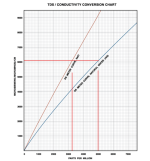I understand that TDS is no longer considered meaningful because tests for CYA and other variables provide more useful information, and I understand that pool store automated test results should be received with skepticism. That said, a neighbor in Phoenix with an 18,000 gallon plaster pool got pool store test results that seem just plain odd. He sanitizes with liquid chlorine. What would cause such a high TDS readout while the other variables are normal, or close to normal?


Last edited:





